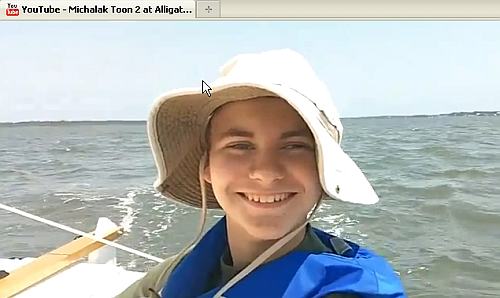Contents
SMALL BOAT RUDDERS
GENERAL...
I have no rule that I use to size a rudder. I just draw something that
looks like the proper size for the boat. I always make it shorter than
the leeboard with the idea that the leeboard will bump the bottom
first, you will notice that and prepare for shallow water or underwater
objects with unlashing the main sheet and having a firm hand on the
tiller. But the question arises, "How much rudder do you need?"
I think the worst condition the rudder will usually see is when running
downwind with the sail boomed way out like this:
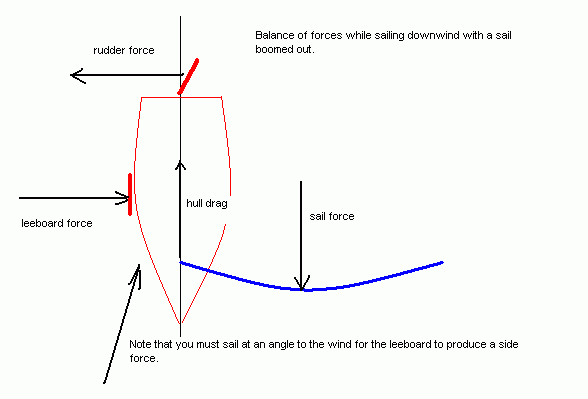
There might be conditions of imbalance during close wind sailing when
the rudder will be overpowered but not if you have done your "sail area
math". So what have we in the above picture? The sail is boomed out all
the way and its force is pulling straight ahead but many feet off to
the side. The hull has a drag equal to the sail's force and the boat
has reached its terminal velocity so to speak. The distance between the
sail force and the drag creates a torque that the rudder and leeboard
must balance. I suppose on an old square rigged boat the sails would
still be on centerline and this condition hardly occurs and you might
hardly need a rudder running downwind. Perhaps the worst case would be
the old catboats with huge booms, short hulls and very shallow rudders.
In the sailing I have done with my own boats the only case of ever
running out of rudder came under this downwind condition with the
original WeeVee. It had a gaff sail, was only 7' long, and I was trying
a shallow end plated rudder. In a brisk downwind no amount of rudder
deflection would hold it on course, it would swing around and round up
into the wind. I found I could "tack" it downwind by sailing a broad
reach instead of running straight downwind. I tried various sizes of
endplates but finally went to a deeper conventional swing rudder as
shown in this article. That cured it! I gave up on shallow rudders.
I think Chris Feller has suggested the rudder on Mixer (and later his
Philsboat, too) was too small. Maybe so but the clear answer on how to
fix such a situation is simply to make the rudder bigger, deeper in
particular since deeper is in general more effective than wider. Almost
any rudder I've ever designed was something that hung on the stern
transom so changing it is pretty easy, unlike say a rudder that is
mounted to a shaft that runs through the hull. Anyway I wanted to point
these things out before getting into the meat of this older article.
BACKGROUND...
Here is an article I wrote a while back that appeared in the great
paper magazine BOATBUILDER. I've included copies of it in my prototypes
catalog since then. The article shows how I've made rudders for my own
small boats.
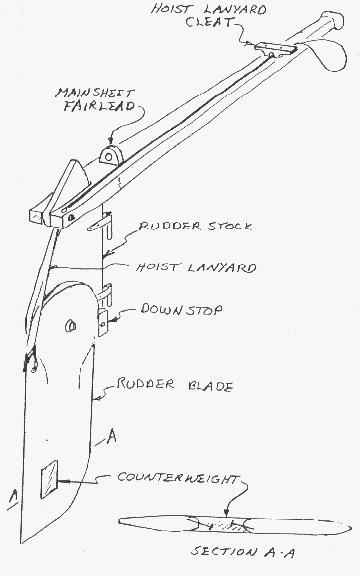
Where I sail only a kick-up rudder works well. It's not because once a
year you might strike a ledge and break off a fixed rudder. It's
because our waters are generally shallow and a fixed rudder would
require endless fussing on every trip. With the weighted kick-up rudder
shown here you just blast along without giving the kick-up blade a
second thought.
I have also tried kick-up rudders that weren't weighted, but were held
down by lanyards. Nearing a shore or shallow I had to play the thing
like a puppet and quickly ran out of hands because the tiller, sheet,
and board all needed handling at the same time. The weighted rudder
blade is much better. In this article I'll show you how I build a
kick-up rudder from the ground up from plywood. This sort of rudder can
be suitable for boats up to about 22 feet length.
RUDDER BLADE...
The best way to make the blade is to laminate it from thinner plywood.
I've seen warped blades made from a single piece of 1/2" plywood, but
I've never had a problem with a blade built up from two layers of 1/4"
plywood.
Cut out the plywood blanks and butter one up with glue. I prefer
plastic resin glue. It comes as a dry powder and is mixed with water to
the consistency of regular white wood glue. It's best to spread the
glue with a notched trowel like you use to paste down floor tiles.
Place the glued-up blanks together on a flat surface protected with
plastic or paper, and tap a couple of light nails through them so they
can't slide around on each other. Apply clamping pressure with weights
like concrete blocks placed atop the blanks. Now stay away until the
glue has set good and hard.
Now give the blade a final trimming and streamline the edges where
required. (If your rudder, daggerboard, leeboard or centerboard
vibrates in use, streamline the edges some more. That almost always
cures the ailment.)
SINK WEIGHT...
I called this the "counterweight" in the drawing but "sink weight" is a
better term.
The sink weight should be slightly heavier than the buoyancy of the
immersed blade. Wood is about half as dense as water, and lead is about
11 times denser than water. It works out that the area of the lead
weight should be about 1/16th the area of the immersed blade, or maybe
7 percent of the area to give a slight negative buoyancy. For example,
a blade that is 10 inches by 15 inches immersed is 150 square inches.
The lead weight could be 150 x .07 = 10.5 square inches, which would be
a square 3.24 inches per side. Cut a hole in the blade for the lead to
the proper size, preferably toward the tip and toward the trailing
edge. Bevel the hole's edges so the lead will lock in place by forming
flanges around the blade. Also place some rustproof nails or screws
around the interior of the hole to further lock the lead in place.
Clamp the blade to a flat metal plate and place it level on the floor.
To figure the weight of the lead required, multiply the area in inches
by the thickness in inches and again by .4. In the example, if the
example blade is 3/4" thick, the weight of the lead required is 10.5 x
.7 x .4 = 3.15 pounds.
To melt the lead, I use a propane camp stove. I place it right next to
the job so I woun't have to tote molten lead around the shop. For a
crucible I use a coffee can with a 1/2" pour hole drilled about 3"
above the bottom of the can, with a long metal handle bolted to the
side of the can. The crucible goes on the stove with enough lead wheel
weights inside sufficient for the pour.
Begin the pour as soon as the lead is molten. (The steel clamps on the
wheel weights will float to the top and not pass through the pour
hole.) Take your time and be very careful with the pour, but it must be
done all at once. Overfill the hole in the rudder blade somewhat to
allow for shrinkage on cooling. Shut off the stove and walk away from
the job for a few hours. Lead stays very hot long after it has
solidified.
If the weight gets loose in the blade due to shrinkage, you can tighten
it by placing the weight over an anvil and hitting the lead with a
hammer. That squeezes the center and expands the perimeter.
Now contemplate what it's like to pour a thousand pound keel!

RUDDER STOCK...
Laminate this exactly as you did the rudder blade. You need to add the
downstop and it's amazing to me how sturdy this part needs to be. A
block of hard rubber or phenolic plastic bolted in place might be best.
TILLER/HOIST LANYARD...
Don't make the tiller too short! Make it too long and shorten it later
if needed. The tiller should fold neatly along the back edge of the
rudder for storage.
Use light braided line, about 3/16" for the lanyard. Tie it to a small
hole in the rudder's trailing edge. The hole needs to be located about
where the raised rudder meets the aft end of the tiller. Then pass the
lanyard through a hole in the back corner of the tiller, then forward
to a small cleat on the top of the tiller. Pass the lanyard through a
small hole in the base of the cleat and tie and loop for your fingers.
To raise the rudder, yank on the lanyard and belay it around the little
cleat. To lower the rudder, uncleat the lanyard and let the blade drop
kerplunk against the stop.
SHEET FAIRLEAD...
This works very well on smaller sails that don't require multipart main
sheets. Screw a fairlead solidly to the tiller's top face. Place the
fairlead right above the rudder hinges so the sheet loads won't affect
steering. Run the sail's sheet through the fairlead and forward along
the tiller. You can secure the sheet merely by wrapping it a couple of
times around the tiller's grip under your steering hand. Then you can
steer and hold the sheet with the same hand. To release the sheet in a
puff you need only slacken your grip without letting go of the tiller.
You can also belay the sheet around the rudder lanyard cleat if you are
feeling lucky.
HINGES...
I haven't figured out hinges yet. I think the best ones are welded up
from stainless steel, but I'm working towards building boats totally
from lumberyard stuff. Stevenson Projects used barrel bolt locks for
hinges. Payson used eyebolts and rods. Dick Scobbie used door hinges
with big cotter pins for pivots. Seeing those, I tried some door hinges
on a dink rudder and was quite satisfied, especially since they came
from the scrap bin. Most door hinges won't mount as simply as real boat
fittings - check out the angles they swing through and do some head
scratching.
One thing I'm sure of: Don't rely on gravity to keep your rudder on
your transom. In a knockdown the rudder may unship and leave you with a
very wet boat and no rudder. Also, with the sheet fairlead on the
tiller as I've shown it, the sheet can produce a large upward force on
the assembly in strong winds and lift the whole thing out of
conventional fittings. Both of these things have happened to me. Now I
secure conventional fittings against knockdowns and sheet loads by
drilling as small hole in one pintle below the gudgeon and putting a
cotter pin through the hole.
THE CARY HINGE...
I wrote the above a few years ago. But very recently I got letter from
Ted Cary in Florida. He has a way of making effective rudder hinges
from scrap seatbelts.
Here is his description:
"Thought you might be interested in my solution to the rudder pintle
problem. My first experience trying to hit two gudgeons with the
pintles in a big chop, while hanging over the transom, disqualified
that system for me. I came up with a simple track and slide system,
then epoxied up the slide and rudder stock around pieces of connecting
webbing strap. The stap flexes when you steer. You can bend a seat belt
a lot of times before it breaks, and nylon doesn't corrode in salt
water. I found that you must align the strap longitudinally across the
direction of the flex, and you must not allow the epoxy to harden on
the strap where it has to flex. But the ends of the strap have to be
well saturated to hold the slide and the rudderstock halves together.
The most successful way I've used to avoid glue where I don't want it
is to get the parts all glued up and assembled with clamps, keeping the
glue off the flex line as much as possible. Then use a syringe or
squirt bottle to saturate the flex line with vinegar, working it
through the fibers, before the glue starts to set. The acetic acid
neutralizes the amines in the epoxy hardener, so it won't polymerize.
The clamped parts won't allow the vinegar to reach the glue on the
strapping between them, so it goes off where you want it to."
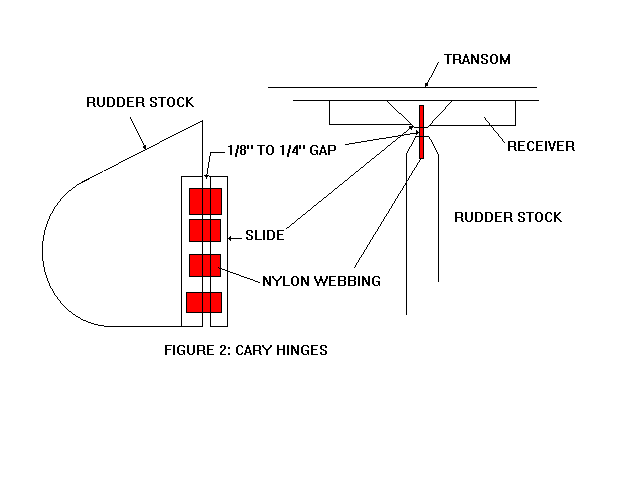
"Dropping the triangular section slide down the transom track installs
the rudder in a fraction of a second.This hinge rig has been working
great on several dinks for over 4 years now."
Well, I must try Ted's system sometime. I think model airplane guys
have been using flexing plastic hinges for a long time. My only comment
might be that I would also lock the slide it to prevent it from
unshipping in a knockdown.
Contents
Blobster
BLOBSTER, SAILBOAT, 16' X 6.5', 750 POUNDS EMPTY
Blobster has a lot of features I like in a boat. Lots of volume for
its size, sort of like Micro or Scram Pram. The multichine shape is
almost exactly like Scram's but this one does not have a Birdwatcher
cabin. It has the more traditional cabin with a raised watertight
deck behind. Also it has one feature I would love to have in my
personal boats - a step-through bow so that when you beach you can go
forward through the cabin and out the front without going into the
water or climbing over the bow. The cabin also has a slot top roof.
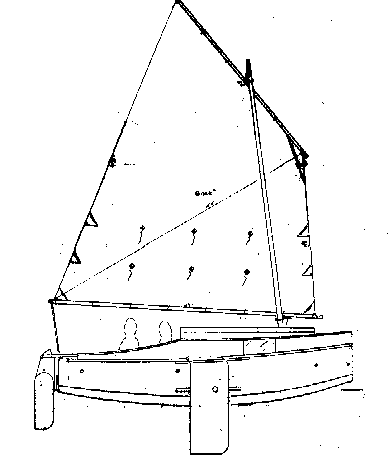
This shape of boat with multichines has proven good in rough water
and with fair speed in spite of its blobular proportions. Blobster
has about 600 pounds of water ballast in its belly and should be OK
to 90 degrees heel although such depends mostly on weight
distribution of the crew, something the designer has little control
over. On the other hand, if the crew jumps overboard the boat will be
almost assured of righting without their help. Then the problem
becomes reboarding. Be prepared!
Sail rig is a large but simple 139 square foot balanced lug on an 18'
mast. Mast is stepped off center to allow you to walk upright down
the slot top and out the front. Should be rigged in an instant with
no one going on deck ever. All very low tech built with common
materials but effective.
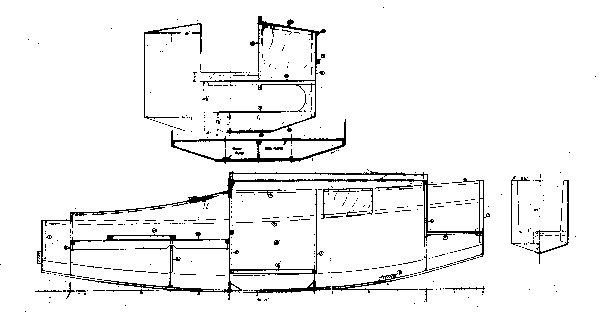
The prototype Blobster was built by Miles Bore in Australia. He had
built several boats prior, including a Micro, and did a great job of
it using very nice materials.
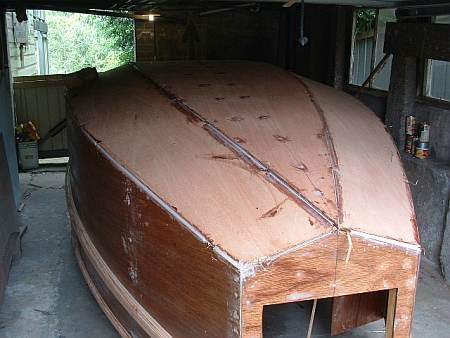
Outside and on its trailer for the first time, the likeness to Micro
is clear. But you can see it was meant to be much easier to trailer
and launch.
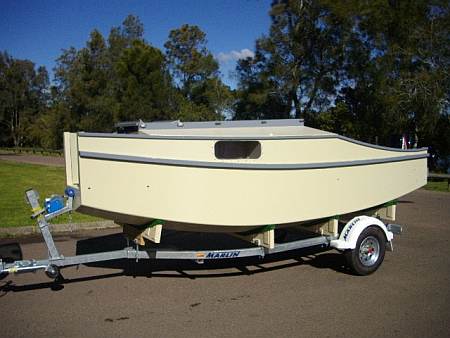
Then he used it for a while as a low power motor cruiser while he
finished the sail rig. You can see how easy the boat was meant to use
from the beach with its step through bow transom.
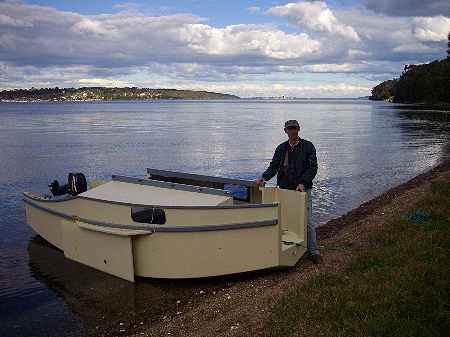
Then for the rig and off for a sail, shown here with ballast tanks
full. Miles reports it sails with no vices so far. No, he hasn't
capsized it yet.
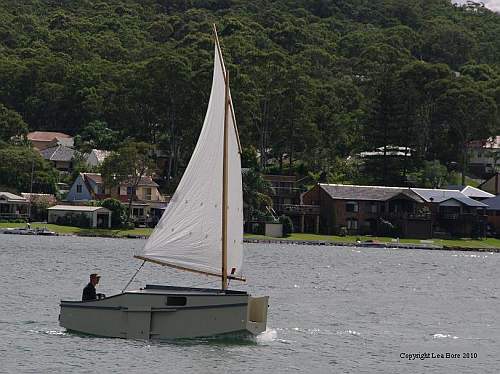
Miles got this photo of the inside. The living platform you see is 7'
long and 6' wide max and about 42" at its deepest from platform to
slot top. With the slot top cabin and step through transom it is a
pretty airy home. Maybe not the little cruiser that Micro is but
clearly much easier to use in general and a good choice for a daysail
when you have but a couple of hours at the lake.
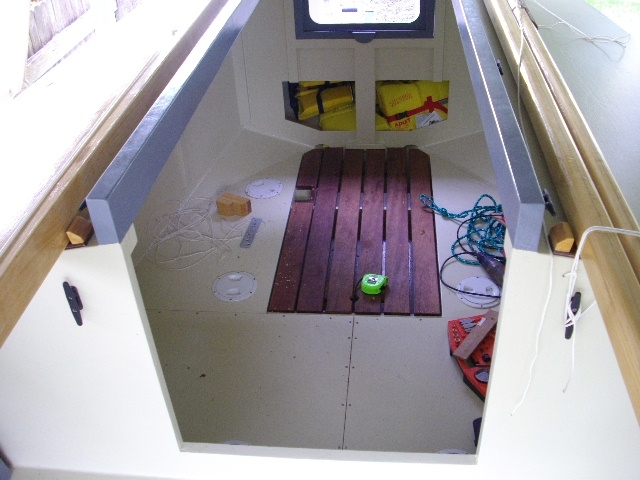
Great job, Miles!
Blobster uses taped seam construction. Five sheets of 1/4" plywood,
eleven sheets of 3/8" plywood and one sheet of 1/2" plywood.
Plans for Blobster are $45.
Contents
Prototype News
Some of you may know that in addition to the one buck catalog
which now contains 20 "done" boats, I offer another catalog of 20
unbuilt prototypes. The buck catalog has on its last page a list
and brief description of the boats currently in the Catalog of
Prototypes. That catalog also contains some articles that I wrote
for Messing About In Boats and Boatbuilder magazines. The Catalog
of Prototypes costs $3. The both together amount to 50 pages for
$4, an offer you may have seen in Woodenboat ads. Payment must be
in US funds. The banks here won't accept anything else. (I've got
a little stash of foreign currency that I can admire but not
spend.) I'm way too small for credit cards.
I think David Hahn's Out West Picara is the winner of the Picara
race. Shown here on its first sail except there was no wind.
Hopefully more later. (Not sure if a polytarp sail is suitable
for a boat this heavy.
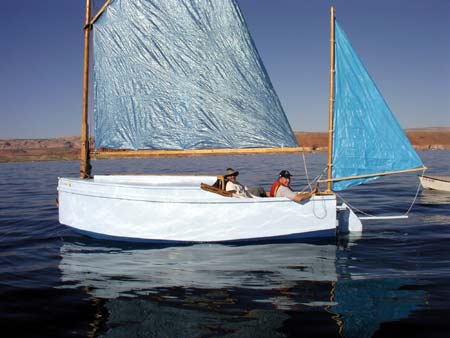
Here is a Musicbox2 out West.
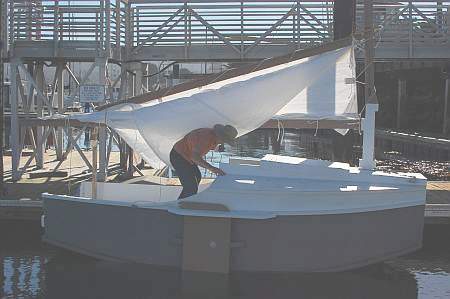
This is Ted Arkey's Jukebox2 down in Sydney. Shown with the
"ketchooner" rig, featuring his own polytarp sails, that is shown
on the plans. Should have a sailing report soon.
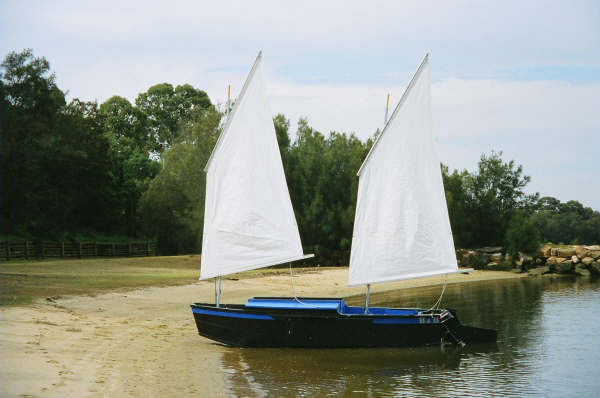
And the Vole in New York is Garth Battista's of
www.breakawaybooks.com, printer of my book and Max's old outboard
book and many other fine sports books. Beautiful job! Garth is
using a small lug rig for sail, not the sharpie sprit sail shown
on the plans, so I will continue to carry the design as a
prototype boat. But he has used it extensively on his Bahamas
trip towed behind his Cormorant. Sort of like having a compact
car towed behind an RV.
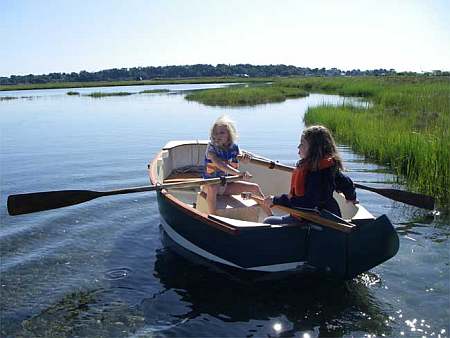
And a Deansbox seen in Texas:
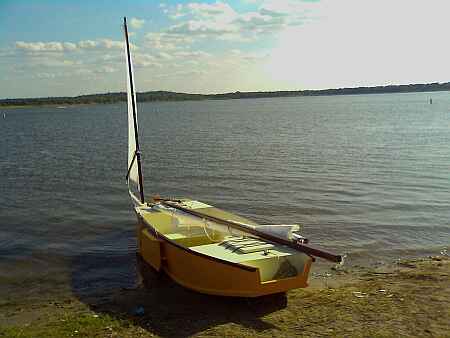
The prototype Twister gets a test sail with three grown men, a
big dog and and big motor with its lower unit down. Hmmmmm.....
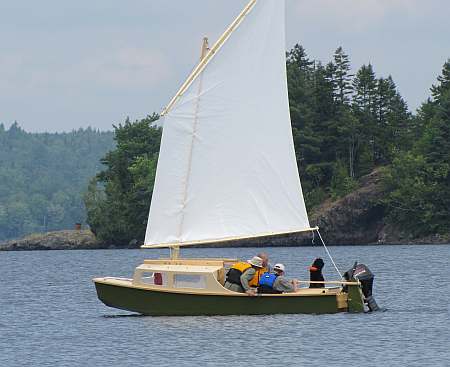
Jackie and Mike Monies of Sail Oklahoma have two Catboxes
underway....
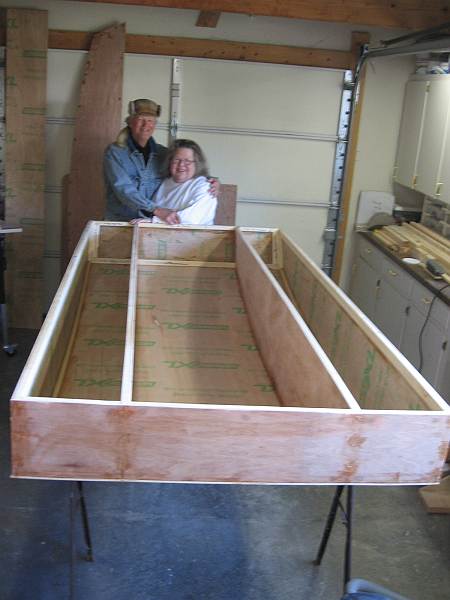
Contents
AN INDEX OF PAST ISSUES
BACK ISSUES LISTED
BY DATE
SOME LINKS
Mother of All Boat
Links
Cheap
Pages
Duckworks
Magazine
The Boatbuilding
Community
Kilburn's Power
Skiff
Bruce Builds
Roar
Dave
Carnell
Rich builds
AF2
JB Builds
AF4
JB Builds
Sportdory
Hullforms Download (archived copy)
Plyboats Demo Download (archived
copy)
Brokeboats (archived copy)
Brian builds Roar2 (archived copy)
Herb builds AF3 (archived copy)
Herb builds RB42 (archived copy)
Barry Builds
Toto
Table of
Contents
